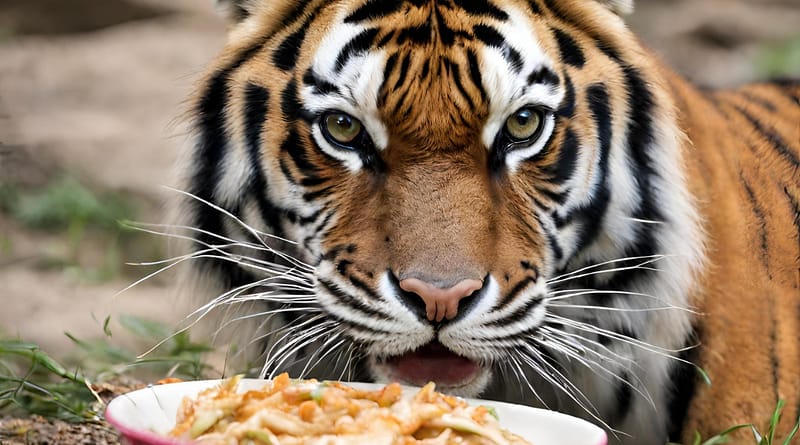What Do Tigers Eat in the Zoo?
Introduction:
Zoos, as guardians of biodiversity, are entrusted with the critical task of preserving and enhancing the lives of the animals in their care. Among these magnificent creatures are tigers, apex predators whose well-being is intricately tied to the thoughtful curation of their diets. In this article, we embark on a journey into the culinary world of zoo tigers, exploring the nuances of what they eat, the challenges faced by their caretakers, and the vital role nutrition plays in their overall health.
The Art of Crafting a Zoo Tiger’s Die:
Designing a diet for zoo tigers is a meticulous process that involves replicating the varied culinary experiences these majestic creatures would encounter in the wild. Zookeepers, armed with knowledge about the natural behaviors and preferences of tigers, strive to create menus that not only meet their nutritional needs but also engage their instinctual behaviors. From the types of meat offered to the enrichment activities designed to stimulate mental and physical health, every element is carefully considered.
The Meaty Menu:
Central to a zoo tiger’s diet is meat, a key component that mirrors their carnivorous nature. Zookeepers meticulously select and prepare a variety of meats, ranging from beef and chicken to horse and rabbit, ensuring a diverse and nutritionally balanced menu. The sourcing of high-quality meat is a challenge that zookeepers continually address to meet the dietary preferences and health requirements of each tiger. The careful balance between lean meats and organ meats mirrors the diet tigers would have in the wild, promoting optimal health and vitality.
Nutritional Boosters for Vibrant Health:
In addition to a meaty diet, zoo tigers receive nutritional supplements to enhance their health. These supplements, including vitamins and minerals, play a crucial role in ensuring the well-being of these captive predators. The careful administration of supplements is based on scientific analyses of each tiger’s individual needs, taking into consideration factors such as age, health status, and reproductive conditions. This holistic approach aims to provide a comprehensive and balanced diet that supports the overall health and longevity of zoo tigers.
Addressing Challenges in Zoo Tiger Nutrition:
Replicating the dynamic and ever-changing diet of tigers in the wild within the confines of a zoo presents numerous challenges. Zookeepers must address individual preferences, monitor the health of each tiger, and adapt diets to changing circumstances. Challenges include sourcing diverse and high-quality meats, managing dietary restrictions, and addressing health issues that may affect a tiger’s appetite. Despite these challenges, the dedication of zookeepers to providing optimal nutrition highlights their commitment to the well-being of the tigers under their care.
Frequently Asked Questions (FAQs):
Q1: Can zoo tigers eat live prey?
Live prey is a complex consideration in zoo settings. While it aligns with the natural predatory instincts of tigers, ethical considerations and the welfare of both the prey and the tiger must be carefully balanced. Zoos often opt for alternatives like feeding whole carcasses or employing enrichment activities to simulate hunting behaviors.
Q2: How is nutritional balance maintained in captivity?
Nutritional balance is achieved through a combination of scientific analysis, regular health check-ups, and dietary adjustments. Zookeepers work closely with nutritionists and veterinarians to monitor the tigers’ health and make informed decisions about their diets. Regular assessments ensure that nutritional needs are met throughout different life stages.
Q3: Are there variations in the diet based on the tiger’s age?
Dietary requirements evolve as tigers progress through different life stages. Cubs have distinct nutritional needs for growth, while adult tigers require diets that maintain muscle mass and overall health. Geriatric tigers may need specialized diets to address age-related concerns. Zookeepers tailor diets to address these variations, promoting the well-being of tigers at every life stage.
Conclusion:
In conclusion, the dietary regimen of zoo tigers is a testament to the dedication and expertise of zookeepers in ensuring the well-being of these majestic creatures. The art of crafting a zoo tiger’s diet involves a delicate balance of nutritional science, behavioral understanding, and a commitment to conservation. From the diverse meat menu to the inclusion of essential supplements, every aspect of their diet is designed to promote physical health, mental stimulation, and the expression of natural behaviors.
Despite the challenges posed by captivity, zoos play a pivotal role in tiger conservation by providing environments that prioritize the health and happiness of these apex predators. As we delve into the culinary world of zoo tigers, we gain a deeper appreciation for the intricate efforts that go into sustaining and enriching their lives. Through careful dietary planning, zookeepers contribute to the preservation of these magnificent creatures, ensuring a future where tigers thrive in both the wild and captivity.









